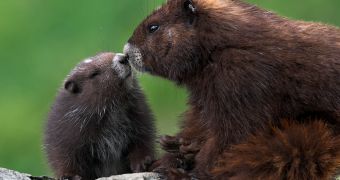Marmots are the world's largest... squirrels! They can be 45 cm (1.5 ft) tall when staying on two feet and weigh up to 14 kg (30 lbs). Marmots inhabit grasslands, from steppes to alpine pastures in Europe, Asia and North America.
They eat twice a day: in the morning and in the evening, basically plants (they even dig for roots), but they can complete their diet and need for proteins with grasshoppers, beetles, worms, bird eggs, and unlike other burrowing rodents, they do not store food in their dens.
Marmots communicate through calls (that can have various meanings) and when two marmots meet they greet each other by... kissing. They mark their territories using secretions of their anal and facial glands.
Besides the main burrow in which they live marmots dig other various burrows on their territory, for emergency, in case they have to hide from a possible danger while being out eating. The main burrow has a central room to which the animals have access through various lateral tunnels, each 1-6 m (3.3-20 ft) long. For orientation inside the burrows the marmots use their vibrissae (whiskers), which act like touch receptors.
In winter, marmots retreat in deeper hibernation rooms, previously garmented with hay, in groups made of 10-15 individuals. The hibernation groups are made of adults and young from various summer burrows, which hibernate crouched one into another.
During the hibernation, the body temperature goes from 36.8 degrees C to less than 8 degrees C, the heart beat is reduced to 3-5 beats per minute, and the breaths are reduced to 2-3 per minute. Every 4 weeks, the marmots wake up for urinating and defecating in special rooms, dug with this purpose on the other side of the burrow, and which have the entrances obstructed by a hermetical plug. The entrance to various rooms of the hibernation burrow are also plugged, but not hermetically, so that a little air circulation takes place.
Hibernation is an endocrine phenomenon, controlled by inner glands, particularly the thyroid. If marmots are exposed to cold weather during the summer, their body reacts by increasing the activity of the thyroid gland, and the metabolism increases to maintain an elevated body temperature; in this case they do not hibernate, thus it seems that daylight rather than temperature indicates them when to begin the hibernation.

 14 DAY TRIAL //
14 DAY TRIAL //